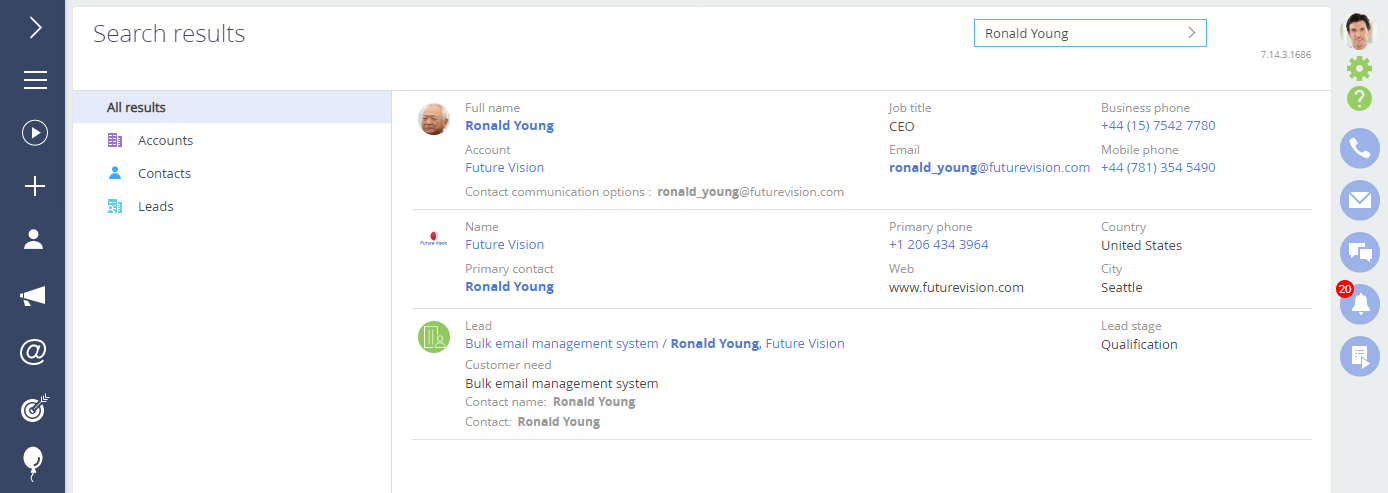You can search the system data by entering a search query in the command line. Creatio always searches in all sections (including custom sections).
Note
On-site users need to perform preliminary registration of the global search. Learn more in the “Global search setup” article.
How to search
-
The records are searched by their text and lookup fields as well as the following details: [Addresses], [Communication options] and [Banking details]. For example, you can find an account by its alternative name, phone number, address or account number.
-
Files and links on the [Attachments and notes] tab of the record page can be found by their name or description.
-
Search requests are processed taking into account common typos and morphology of different word forms in English (other languages are not currently supported). The query is not case-sensitive. You only need to enter the search text, for example, contact last name or the name of the knowledge database article. For a more accurate search, add more details to your search query, for example, “ronald young director future vision".
Note
To include certain section’s data in global search results, open the section wizard for the necessary section and select the [Indexing for full-text search] checkbox. Learn more about indexing in the “Configure section properties” article.
Indexing is enabled in the following sections by default: [Contacts], [Accounts], [Employees], [Knowledge base], [Leads], [Opportunities], [Products], [Orders], [Invoices], [Contracts], [Documents], [Projects], [Services], [Service agreements], [Configuration] (advanced settings), [Cases], [Problems], [Changes], [Campaigns], [Events] and [Marketing plans].
How the search results are displayed
The search results are displayed as a list of records containing the text of the search query or a part of it. The text that matches the search query is highlighted in bold for each found record (Fig. 1).
Fig. 1 A list of search results

The results are ranked by relevance both in the actual results list and with any configured filters. For example, if the search is performed from the [Contacts] section the records of this section are displayed at the beginning of the list, and records from other sections of the system will be displayed below. For example, if you set up a filter by contact on the search result page, contacts with matching names will be displayed at the top of the list.
If a user does not have permissions for a specific object column, e.g., for viewing an invoice amount, such column is not displayed on the page of global search results.
Note
The rules for displaying search results are determined using the [Global search default entity weight] and [Global search default primary column weight] system settings.
To display search results taking morphology, typos and fuzzy matches into account enable the [Display search results with partial match] system setting.
To manage the amount of displayed search results with partial match and increase the chances of finding data for inaccurate search requests, set a value for the “Match threshold for displaying in search results (percent]” system setting.
System settings are described in more detail in “The [System settings] section” article.
Example: searching contacts by phone number
Lets find a contact by its phone number.
1.Enter the phone number in any format in the command line. You can enter only part of the number, with or without special delimiter characters.
2.Click the  button or press the [Enter] key.
button or press the [Enter] key.
After processing the search query, a list of results will be displayed with the contact you were looking for at the top of the list and other records that contain the entered phone number afterwards.
Displaying multi-language data
Starting from version 7.14.0, Creatio can display localized data in the global search results in the preferred language of the user. For example, if the [Full name] field is localized, French users will see its value in French, and English users will see it in English.
This option is enabled via the “Show localized data in the global search results” system setting (UseLocalizableGlobalSearchResult). If the setting is disabled, localized data will be displayed according to the language selected for the system user (specified in the “System operations user” system setting).
Note
Data localization is enabled using development tools. Read more in the “Enabling multi-language object schema” article.
See also






